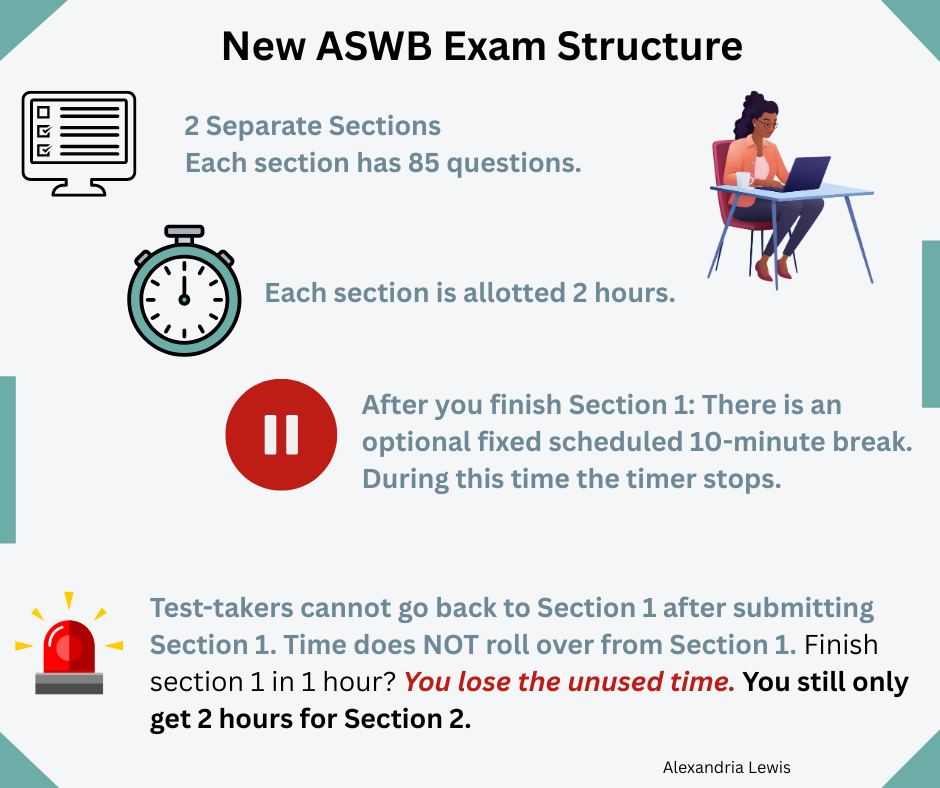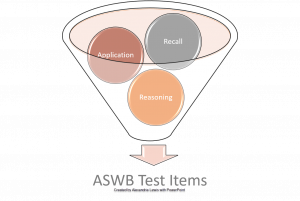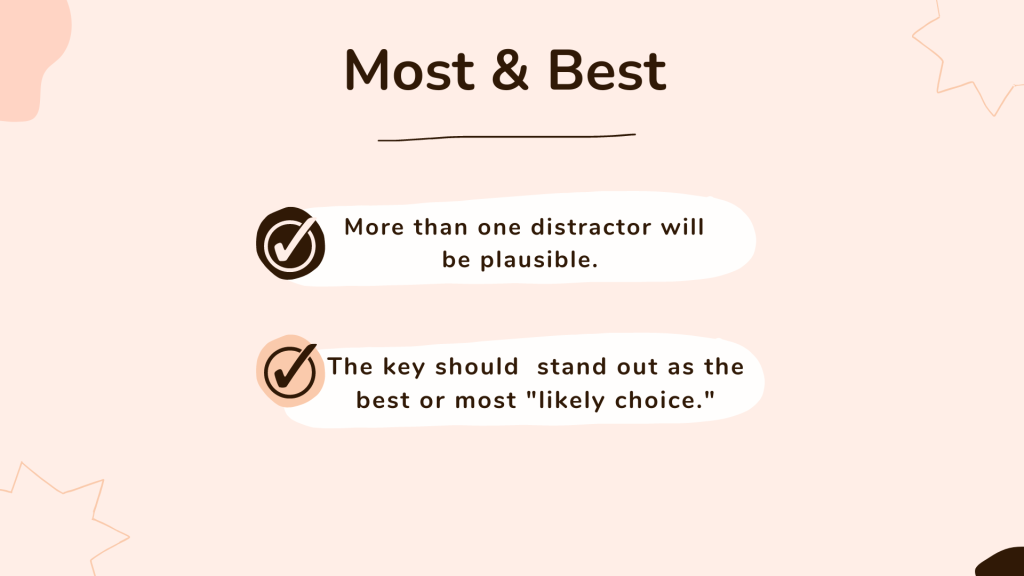1 Exam Overview
Alexandria Lewis
Exam Highlights
The Association of Social Work Boards (ASWB) holds ownership of the national social work exams.
There are several levels of licensure exams:
Bachelors ($230)
Masters ($230)
Advanced Generalist ($260)
Clinical ($260)
There are 170 questions on these exams. The ASWB pilots 20 questions, and these questions are not scored. Test-takers do not know which questions are piloted. According to the ASWB website, test-takers need to answer approximately 90-107 questions correctly to pass the exam. The number of correct answers required to pass varies depending on the difficulty of the generated exam. For example, you may end up with an exam with easier questions than another test taker. In this scenario, the ASWB expects more correct answers than in an exam with harder questions. Points are not deducted for incorrect answers.
Major Exam Administrative Change: The ASWB has changed the exam structure. The questions are now divided into two sections, and test-takers cannot go back to any questions in the first section after finishing section one.

Resources:
- ASWB Resource: Exam Appointments.
- Pearson: Find a Test Center.
- ASWB Application for Disability & Language Accommodations
- Examination Guidebook (April 14, 2025)
Masters Exam
The ASWB Content Outlines and KSAs (knowledge, skills, abilities) are available for free on the ASWB website. I recommend printing the content outlines and KSAs as a resource.
MSW Content Areas (KSAs)
| Percentage of Exam | KSAs |
| 27% | I: Human development, diversity, and behavior in the environment. |
| 24% | II: Assessment and intervention planning |
| 24% | III: Interventions with clients/client systems |
| 25% | IV: Professional relationships, values, and ethics |
Content Outline
The bold information below is referred to as the content outline, and the subsections are considered competencies—the content outline and KSA document list KSAs under each competency group. The questions on the exam do not identify the content outline, competencies, or KSAs in the questions.
I. Human development, diversity, and behavior in the environment
I.A. Human Growth and Development
I.B. Concepts of Abuse and Neglect
I.C. Diversity, Social/economic justice, and oppression
II. Assessment and intervention planning
II.A. Biopsychosocial history and collateral data
II.B. Assessment methods and techniques
II.C. Intervention planning
III. Interventions with clients/client systems
III.A. Intervention processes and techniques for use across systems
III.B. Intervention processes and techniques for use with larger systems
IV. Professional relationships, values, and ethics
IV.A. Professional values and ethical issues
IV.B. Confidentiality
IV.C. Professional development and use of self
Source: ASWB Masters Course Outline and KSAs

You will notice there are many KSAs (212) listed in the content outlines. Unfortunately, the exams can present like a game of chance because test-takers do not know which KSAs will be on the exam. For instance, some ASWB Masters exams have questions about medications, while other exams might not have any medication questions. The ASWB exams are not structured based on a baseline of the core information that every social worker should be tested on, which is another problem with the exam. For instance, if all MSW-level social workers should be familiar with psychotropic medications, all exams should have medication questions. These issues are important to consider when studying for the exam.
Exam Structure Basics
The ASWB refers to the questions as “items,” since this is a term used in the testing industry.
The item structure includes the following:
- Stem: Content (description).
- Distractors: Incorrect Item choices.
- Key: Correct answer.
Example:
What term is used to refer to the extent to which the scores from a measure represent the variable they are intended to? [Stem]
A. Validity [Key]
B. Reliability [Distractor]
C. Construct [Distractor]
D. Systematic error [Distractor]
All the exam items are multiple-choice, with three or four choices. There are no item choices such as none of the above, all the above, or a combination of two item choices (A & C). Effective January 2023, the ASWB started using some three-answer choice questions (A, B, C). There will be an increase of questions with three-answer choices.
Stems are presented as:
- Direct questions
- Statements
- Vignettes
Some items include the following words (referred to as qualifiers):
- Next
- First
- Most
- Best
Stems are written in active voice, present tense, and do not use negative words such as Not and Except. Qualifiers on the exam will be in bold and in all caps.
Example
The social work case manager finishes conducting a biopsychosocial assessment of a client. What should the social worker do NEXT:
A. Establish rapport
B. Implement an intervention
C. Terminate services
D. Work with the client to set goals
Answer: D.
Rationale: The context of this item is the generalist social work practice model (engagement, assessment, planning, implementation, evaluation, and termination). Distractors can read as good responses, so it is essential to analyze the question through the lens of the qualifying word (e.g., next, first, best).
There are three types of questions/items, and the ASWB also refers to these as cognitive levels:
- Recall
- Application
- Reasoning

Recall
Recall items draw upon remembering definitions, theories, perspectives, and concepts. These questions typically do not include lengthy scenarios but can include descriptions. The ASWB refers to these items as level one; these questions can present as statements or direct questions.
Examples
1. During an assessment with a client recently diagnosed with a substance use disorder, the client tells the social worker, “I do not really have a problem, and I don’t see the need for change.” The client is in what transtheoretical model stages of change?
A. Contemplation
B. Determination
C. Precontemplation
D. Maintenance
Answer: C
2. Which medication is an anti-anxiety agent?
A. Benzodiazepines
B. Monoamine oxidase inhibitors (MAOIs)
C. Depakote
D. Lithium
Answer: A
Application
The ASWB refers to application questions as level two. Application questions build on recall in that these questions require the ability to use one’s knowledge applied to a vignette or description of certain circumstances.
Example
1. A hospital social worker receives a physician’s order to discharge an 85-year-old patient who is alert and oriented to a nursing home for physical therapy. What should the social worker do FIRST?
A. Talk to the patient’s adult children about the discharge plan.
B. Talk to the patient about the patient’s goals.
C. Ask the physician which nursing home the patient should be sent to upon discharge.
D. Call the nursing home to set up the patient’s transfer.
Answer: B.
Rationale: A few answer choices are steps a social worker would take during the discharge process (B, D). The answer choice that sticks out as problematic is “C” because patients and families have the right to choose their providers. Social workers should always speak to the client about their goals, regardless of the client’s age. Before sharing information with the family, the social worker needs to obtain consent from the patient since the patient is alert and oriented. Notice the qualifier is “first.” Some of the knowledge used for answering this item includes the right to self-determination, autonomy, starting where the client is, and seeing the client as an expert. When responding to questions about older adults, pay close attention to any item choices that present as paternalistic.
2. A hospital social worker meets a 90-year-old patient scheduled to be discharged in two days. The patient hospital team recommends the patient be discharged to a nursing home. The patient mentions they want to be discharged home with home health services. What should the social worker do NEXT?
A. Conduct a mental status exam.
B. Talk to the patient about the patient’s goals.
C. Assess the safety of the patient.
D. Determine which home health agencies the patient prefers.
Answer: D
Rationale: Similar to the previous rationale, use caution in making assumptions about an older adult’s mental and/or cognitive status solely based on age (A). The patient has told the social worker their goals for going home with home health, so (B) would not be a suitable answer choice. Since the patient has expressed goals, the social worker should next determine which home health agencies the patient prefers (D).
Reasoning
The ASWB categories reasoning items as level three. Scenarios require test-takers to interpret and analyze information in the scenario to determine the correct answer. Remember to read and analyze this information through the lens of a standardized national exam.
Example
1. A social worker meets with a 70-year-old patient who is an emergency department for an injury because of a fall at home. The patient recently had surgery for a broken hip at the hospital. During a mental status exam, the patient feels confused and cannot remember the calendar day. The patient also shares his daughter pushed him and hurt him. What should the social worker do FIRST?
A. Evaluate the patient for dementia.
B. Report the allegations of elder abuse to the appropriate regulatory authority.
C. Consult with medical staff to evaluate the patient for delirium.
Answer: C
Rationale: This item requires some knowledge of delirium and dementia. Since delirium is dangerous and would need to be evaluated first, the social worker should consult first with the medical staff to evaluate the patient for delirium.
Mechanics of qualifiers
In the following video, I highlight approaches to consider when answering first and next questions.
Note: There is an error on the KSAs slide! Assessment should be “Abilities.”
Most and Best

In the ASWB social work educator training I completed regarding how to write exam questions, there is supposed to be a distinction between FIRST questions and NEXT questions. FIRST questions should have answer choices that may occur later but are not completed FIRST. Whereas NEXT questions should be written in a manner where a social worker has already engaged in something in the question. All answer choices may present as plausible but not completed NEXT as related to what is described in the question itself.
Here is an example using the same macro social work scenario, but with two different questions. One with FIRST and one with NEXT.
Question 1: You are a social worker in a community agency and have been assigned to address concerns from community members about youth who are struggling with substance use and have limited access to resources. Several community members have expressed both concern for the youth and a desire to support them. What should the social worker do FIRST?
A. Develop a prevention and support program for youth in the community.
B. Meet with community members, youth, and key stakeholders to learn more about their concerns, strengths, and ideas for solutions.
C. Contact local treatment providers to arrange referrals for all youth in the neighborhood.
Question 2: You are a social worker in a community agency that has been working to address concerns about youth in the neighborhood who are struggling with substance use and have limited access to resources. Over the past month, you have held several listening sessions with community members, including youth and key stakeholders. What should the social worker do NEXT?
A. Collaborate with community members and youth to co-design initiatives such as peer mentoring, prevention programs, or expanded access to supportive services.
B. Repeat the listening sessions to revisit the same concerns before taking any steps toward action.
C. Contact local treatment providers to arrange referrals for all youth in the neighborhood.
Correct Answers:
- Question 1: B
- Question 2: A

